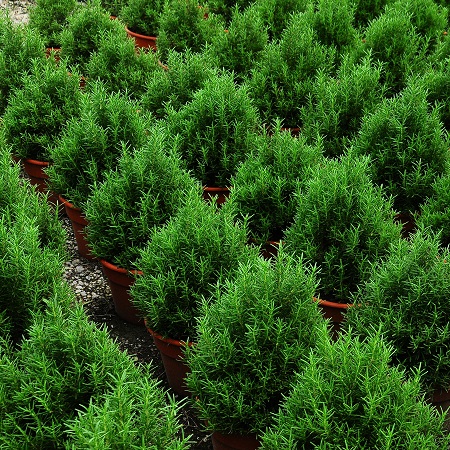
Rosmarinus officinalis or Rosemary Christmas Plant is a fragrant shrubby Mediterranean mint having grayish-green needle like leaves used as a seasoning. Rosemary is equally happy in a pot or in the garden and can be planted outdoors in full sun, in frost-free climates. When growing Rosemary in cold climates, they should be planted in pots and brought indoors when temperatures drop to 30 F or lower. Rosemary resembles a miniature spruce, when conically pruned. It does not need frequent waterings after it is established but should get at least four to six hours of direct sunlight each day. Rosemary makes a great container plant for high light areas, such as, western facing window and can also be grown under grow lights. Rosemary can be used to season foods and is very fragrant and when used as an indoor plant, it will infuse any room with a strong rosemary fragrance. It is traditionally used to bring holiday and Christmas season cheer. For longevity, mist indoor plants during the winter. The plant has perfect pyramid shape with strong branching for hanging tiny Christmas decorations.
Rosemary leaves have a tea like fragrance and a pungent, slightly bitter taste. They are generally used sparingly, dried, or fresh, to season foods, particularly lamb, duck, chicken, sausages, seafood, stuffing, stews, soups, potatoes, tomatoes, turnips, other vegetables, and beverages. Whole sprigs are removed before food is served because of their powerful taste. Add Rosemary to roasted potatoes for the last 15 minutes for a delicious dish.
In ancient times Rosemary was believed to strengthen the memory; in literature and folklore it is an emblem of remembrance and fidelity. Rosemary is slightly stimulating; in traditional medicine it was a popular aromatic constituent of tonics and liniments. Today, its fragrant oil is an ingredient in numerous toiletry products and in vermouth. Native to the Mediterranean region, it has been naturalized throughout Europe and temperate America and is widely grown in gardens in the warmer parts of the U.S. and in Great Britain, where an old garden legend reads “where Rosemary thrives the mistress is master.”
The Rosemary bush has a main stem usually around 3 feet tall but sometimes up to 7 feet tall, and linear leaves about .4 inches long resembling curved pine needles, dark green and shiny above, white beneath, and with margins rolled back onto the under face. The flowers are bluish, in axillary clusters. Bees of all kinds are particularly fond of Rosemary. The essential oil content is from 0.3 to 2 percent and is obtained by distillation; its principal component is borneol. It is an evergreen shrub with rich green needle-like foliage and clear lavender blue flowers. Rosemary blooms during the Autumn-Winter seasons and intermittently throughout the year where temperatures are above 32 F.
Related Articles & Free Email Newsletter
Dried Herbs Require Little Work and Offer a Great Reward
High Quality CBD Products with No THC


Comment here